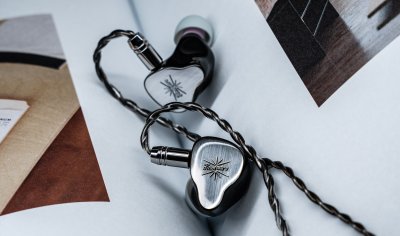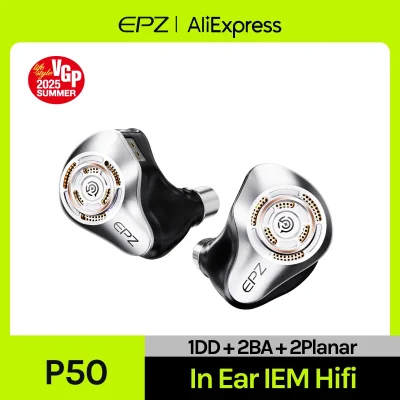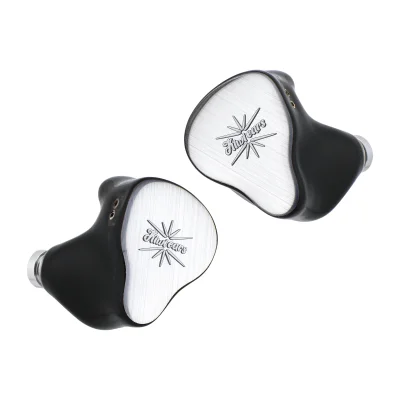Kiwi Ears KE4 and EPZ P50 use 2DD+2BA and 1DD+2BA+2Planar driver setups respectively. Kiwi Ears KE4 costs $199 while EPZ P50 costs $205. EPZ P50 is $6 more expensive. EPZ P50 holds a slight 0.1-point edge in reviewer scores (7.2 vs 7.2). User ratings place Kiwi Ears KE4 at 6.5 and EPZ P50 at 9.5. EPZ P50 has significantly better bass with a 1.1-point edge, EPZ P50 has better mids with a 0.8-point edge, EPZ P50 has significantly better treble with a 1-point edge, EPZ P50 has better dynamics with a 0.5-point edge and EPZ P50 has better soundstage with a 0.6-point edge.
Insights
| Metric | Kiwi Ears KE4 | EPZ P50 |
|---|---|---|
| Bass | 7 | 8.1 |
| Mids | 7.3 | 8.2 |
| Treble | 6.7 | 7.7 |
| Details | 7.2 | 8.3 |
| Soundstage | 7 | 7.6 |
| Imaging | 7.2 | 8.4 |
| Dynamics | 6 | 6.5 |
| Tonality | 7.1 | 7.3 |
| Technicalities | 6.8 | 7.3 |
Kiwi Ears KE4 Aggregated Review Score
Average Reviewer Scores
Average Reviewer Score:
7.2Generally Favorable
EPZ P50 Aggregated Review Score
Average Reviewer Scores
Average Reviewer Score:
7.2Generally Favorable
Reviews Comparison
Kiwi Ears KE4 reviewed by Audio Amigo
Audio Amigo Youtube Channel
Buy Kiwi Ears KE4 on Linsoul
Ad
Price: $199
Buy Kiwi Ears KE4 on Linsoul
EPZ P50 reviewed by Audio Amigo
Youtube Video Summary
EPZ P50 comes as a tribrid at $185 with a surprisingly complete kit: a sturdy leatherette case, modular 3.5/4.4mm terminations, three silicone tip sets, and a cleaning cloth. The resin shells are semi-custom with aluminum faceplates; comfort is generally good but anatomy-dependent, and the stock cable—while well finished—runs on the stiff side. A standout twist is the factory customization option (~$225 total for the “Grindphones” style), which notably doesn’t alter the tuning in any meaningful way. The set is easy to drive, shows minimal change with impedance adapters (a touch warmer/more vocal-forward), and avoids pressure issues thanks to smart internal venting.
Sonically, tuning sits as a controlled, mild V: bass is just north of neutral with pleasing texture and impact, mids stay clean with an engaging female-vocal emphasis, and treble adds airy sparkle without turning tizzy—though insertion depth can trigger length-mode variability for some ears. Technical chops impress at the price: detail retrieval punches up, imaging is precise with good separation, and stage reads average but coherent. Against peers, P50 feels more resolving than Kiwi Ears K4 (trades bigger bass/sparkle for better mid clarity), brighter and more vocal-present than the neutral-leaning Ziigaat Lush, and echoes a Dunu Da Vinci vibe with less bass. Verdict: tremendous value and a terrific pick for vocal-centric libraries—highly recommended to audition first if treble sensitivity or fit quirks are a concern.
Audio Amigo Youtube Channel
Buy EPZ P50 on Aliexpress
Ad
Price: $199
Buy EPZ P50 on Aliexpress
Kiwi Ears KE4 reviewed by Super* Review
Youtube Video Summary
Kiwi Ears KE4 is a $200 hybrid (2DD+2BA) that showcases the so-called “new meta” tuning—more body in the lower mids and a calmer lower treble versus the Harman Target. Packaging is simple: a pocketable case and bespoke silicone tips (usable, though even shorter tips can improve comfort). The cable handles well but feels a bit thin/kinky with heat-shrink earhooks, and the shells look plain, prototype-like. Fit is secure and comfy with a semi-custom shape, albeit a touch thick, so they can protrude from the ear.
Sonically, KE4 delivers a warm, low-contrast midrange that makes vocals sound natural and well-placed, with a pleasant mid-treble “frothiness” adding texture. Bass quantity leans on the mid-bass, but quality is the weak spot—soft/bloomy and a bit poofy, lacking density and punch, which can dull drive on bass-heavy tracks. Imaging is decent, treble is safe and balanced (not sharp or dark), and overall technicalities are respectable without chasing wow-factor.
Against peers: Truthear Hexa mirrors the new-meta mids with tighter, better-controlled bass; AFUL Explorer is more engaging with tighter slam and slightly crisper treble; the Harman-leaning Binary Chopin brings the best bass attack. KE4 is a strong choice for vocal-first listening and a clear example of the new meta, but the bass bloom can hold it back across a broad library. Verdict: a very solid 4/5 stars.
Super* Review original ranking
Super* Review Youtube ChannelEPZ P50 reviewed by Super* Review
Youtube Video Summary
EPZ’s P50 feels like a breakout for the brand: a compact, medium-small shell with a vented faceplate that’s marketed as “open-back,” yet isolates like a typical IEM. The unboxing is tidy at this price—carry puck, a real microfiber cloth, and two sets of generic tips—while the modular cable (screw-lock swappable termination) is handy if a bit thin, stiff, and kink-prone; the 2-pin plug sits slightly proud of the socket and the “R” marking is visible on the outside. The long nozzle (~5.5 mm diameter) can push fit depth, so shorter tips (e.g., NF Audio-style) help; once set, stability and comfort are excellent. Overall build looks clean and modern, if a touch editorial compared with EPZ’s other shells.
Sonically, P50 embraces the current tilted diffuse-field “new meta” with a mostly neutral, natural presentation and a later-rising, sub-bass-centric lift that gives bounce rather than mid-bass thump. There’s a hint of extra presence around the 4–5 kHz region that adds macro-contrast—vocals pop with definition and separation is crisp—while upper treble stays safe: cymbals are clean but a bit light in weight. Bass is tight and incisive rather than slammy; micro-texture on vocals is good, though the set favors that big, “stagey” contrast over ultra-fine grain. It’s easily EPZ’s best tuning so far: clear, organized, and engaging without drifting from neutral-ish aims.
Against peers, Kiwi Ears K4 tracks a similar target but sounds lower-contrast and can blur on dense mixes; P50 hits harder on transients, images more cleanly, and keeps busy tracks sorted, while K4 offers a richer midrange with “frothier” treble. Versus the Binary Chopin, Chopin is warmer, fuller, and more mid-bass driven—more “analog” and atmospheric—with deeper perceived space but a bulkier fit; P50 is leaner, clearer, and the least bass-forward of the three. Verdict: a confident 4/5 for delivering a small, comfy fit and a clean, contrasty neutral that competes squarely around $200–$250. If the brief is “neutral with a bit of drama,” this is a strong pick—and a promising sign of where EPZ can go next.
Super* Review original ranking
Super* Review Youtube ChannelKiwi Ears KE4 reviewed by Jaytiss
Youtube Video Summary
Build & accessories: understated box, a surprisingly nice cable with a “juicy” feel and flat 2-pin connectors, plus extra filters. The stock tips are the weak link—thin out note weight and feel downright horrific, so a tip swap is recommended. The medium-to-large shell is a highlight: secure fit, comfy nozzle size, and a handsome faceplate that looks premium in ear. Overall ergonomics and finish scream daily-driver friendly.
Sound: impactful, well-judged bass, lively upper mids, and a touch of upper-air jank; for $200 it’s a strong value with a clean, modern JM1-style tuning. Easily the most convincing Kiwi Ears to date: more balanced and natural than Quintet (which pushes upper mids/10 kHz energy), far more sensible than the treble-shouty Forteza, a clear upgrade over budget options like DLS and the tiny, poorly packaged Singolo, and less fatiguing than the bass-and-upper-mid heavy Melody. Against $200 benchmarks, KE4 becomes a new reference—cleaner male vocals and better build than “Chopin,” and a tighter low end plus tidier mids than AFUL Performer 5. Trades blows with Hype 4 at a fraction of the price; those craving a pricier step-up in the same vein can eye HiSenior Mega5EST. Measured verdict: Tier A, 3-star, 8.8 for tone—good imaging, solid soundstage, gamer-friendly, not flawless but genuinely excellent once re-tipped. A handsome, comfortable set that delivers outstanding value for newcomers and gift-givers alike.
Jaytiss Youtube Channel
EPZ P50 reviewed by Jaytiss
Jaytiss Youtube Channel
Kiwi Ears KE4 reviewed by Jays Audio
Youtube Video Summary
Kiwi Ears KE4 plays a warm-leaning, smooth and relaxing set at mid volume with slightly laid-back vocals and a good sense of space. The real trick is volume scaling: turn it up and the upper-mids/treble step forward with more detail without becoming shouty, while the bass grows thumpier and digs deeper. A 1 kHz scoop plus a tasteful ~3 kHz lift (gentler than Harman) keeps vocals extended yet non-fatiguing; the trade-off is vocal power/weight, which stays a touch mild compared to sets like RS5.
Driven by dual dynamic drivers, the KE4’s low end is among the best under $200 for texture, slam, and note weight, making the tuning feel full and grounded. It’s not as razor-quick in transients or as surgical in imaging as certain planars or techy hybrids, but the payoff is a more natural timbre. Treble sits in a balanced pocket—neither splashy nor dark—with none of the plasticky shimmer or planar/PZT glare.
Against peers: Supermix 4 and Quintet (and even the cheaper “Conta”) push more micro-detail and separation; Orchestra Light is the cleanest/most neutral but softer in bass and more complete in vocals. Versus CKLVX and PULA, KE4 trades their airy, sometimes peaky sparkle for a smoother, more grounded presentation and richer bass grip. Compared with Explorer, KE4 offers a clear step up in technicalities and low-end authority, while Explorer stays more intimate. Net: not the new “benchmark” at $200, but as a crank-it-up, musical all-rounder with standout bass and fatigue-free top end, KE4 is an easy favorite.
Jays Audio Youtube Channel
EPZ P50 reviewed by Jays Audio
Youtube Video Summary
The EPZ P50 comes in hot as a new tribrid and a potential $200 neutral benchmark, trading sterile restraint for a more vocal-centric presentation. Versus the MEGA5EST, vocals sit a touch more forward—adding emotional weight and clarity—while the MEGA5EST still edges it on sheer smoothness and EST “air.” Compared to Meteor, the P50 fills in the lower mids, dials back 1–3 kHz glare, and opens the top end a bit; Meteor stays a hair softer up top. The catch is bass: the P50’s DD is competent but not a sub-bass shaker—expect clean rather than authoritative slam.
Against peers, the P50 sounds fuller and more natural than Supermix 4 (which is brighter and more “hi-fi” energetic), and it trades blows with Odyssey: Odyssey brings better bass texture and treble micro-detail, while the P50 delivers superior vocal clarity and a touch more air. It excels at mid-volume listening—Volume S needs more gain to bloom—and outclasses lighter, air-tilted sets like “K4” style tunings when male vocals or body are the priority. Accessory game is strong too: a nicer cable and a genuinely sturdy hard-leather case sweeten the deal. Not the most “unique” flavor and not for bassheads, but as a balanced, clean, vocal-forward option around $200, P50 is an easy recommendation for those chasing neutrality without the vanilla.
Jays Audio Youtube Channel
Kiwi Ears KE4 reviewed by Tim Tuned
Tim Tuned Youtube Channel
EPZ P50 reviewed by Tim Tuned
Tim Tuned Youtube Channel
Kiwi Ears KE4 reviewed by Gizaudio Axel
Gizaudio Axel original ranking
Gizaudio Axel Youtube ChannelEPZ P50 reviewed by Gizaudio Axel
Kiwi Ears KE4 reviewed by Head-Fi.org
EPZ P50 reviewed by Head-Fi.org
Kiwi Ears KE4 (more reviews)
Kiwi Ears KE4 reviewed by Bad Guy Good Audio
Youtube Video Summary
Kiwi Ears KE4 drops at $199 and comes across as the best-tuned Kiwi Ears yet. Unlike the Orchestra Lite with its sub-bass roll-off or the budget Cadenza that skews a bit dark, this set keeps the sub-bass present and tight. Compared to the Dolce (energetic with more mid-bass) and the Quintet (politer bass, lighter upper-mids/late treble), KE4 adds more slam while smartly tucking the mid-bass so vocals stay clean. It’s a tuning that both looks right on the graph and lines up with real-music listening across hip-hop/R&B, rock, and acoustic cuts.
Low-end tests—808 drops and bass-guitar lines—hit clean and natural, and kick-drum transients keep their body instead of drying out. Female vocals get clarity without mid-bass haze, while male vocals avoid thinning—nicely balanced through the mids. The treble is managed with some late-treble roll-off, avoiding glare while preserving harmonic bite for guitars and cymbals over longer sessions. Net result: no qualifiers, no obvious weak spot, and performance that competes hard at $199. Easy recommendation and a frontrunner for the brand’s lineup to date.
Bad Guy Good Audio original ranking
Bad Guy Good Audio Youtube ChannelKiwi Ears KE4 reviewed by Z-Reviews
Youtube Video Summary
Kiwi Ears KE4 is a 2DD + 2BA hybrid touting an isobaric subwoofer system and “sub-bass impact and slam.” The reality doesn’t match the brochure: the $200 package feels plain—simple box, basic case, few tips, and a generic 3.5 mm cable—while the tuning comes across as safe to a fault. Marketing promises of kick drum thump and bass guitar presence give way to a presentation that’s competent but uninvolving.
On music, the low end skews mushy rather than tight, transients lack bite, and the overall tone reads flat—the kind of “waiting-room” vibe that prompts a double-check of DSP settings. Even with a strong seal from premium tips, energy and excitement refuse to show up; it’s “fine ingredients, bland dish.” Technicals aren’t a disaster (it’s not unclear), but fun factor feels negative, recalling ultra-neutral sets like Softears Studio 4S that impress more than they engage. Verdict: about a 6/10 (maybe 7/10 on a generous day), with better value found in a cheaper Kiwi alternative at roughly half the price—skip the KE4 if musical thrill is the goal.
Z-Reviews Youtube Channel
Kiwi Ears KE4 reviewed by
 Fresh Reviews
Fresh Reviews
Youtube Video Summary
$199 hybrid with 2DD+2BA, the Kiwi Ears KE4 pairs a glossy, translucent faceplate with an ergonomic 3D-printed resin shell for all-day comfort. The stock 3.5 mm cable is light and flexible, the new silicone tips seal well, and spare filters are included. Sonically it follows the diffuse-field “new meta” tuning popularized by sets like Moondrop x Crinacle Dusk, Dunu Da Vinci, and Mega5 EST—but arrives as the most affordable in that crowd. Tonality leans a touch warm with a smooth upper-mid/treble that keeps gunshots from sounding harsh; for music, the presentation feels immersive and lively at the price.
For competitive play, performance varies by title. In Valorant: B, horizontal imaging and depth cues are convincing, and footstep “thumps” pop through clearly, aiding reaction time. In Apex Legends: B–, basic imaging and map awareness are fine, but busy fights expose separation/layering limits and a slight haze to light taps and micro-details. In Call of Duty: C+ (borderline B–), clarity and detail retrieval dip during chaotic moments and the game’s occlusion/breathing effects mask cues more than preferred. Overall, a stylish, comfortable DF-tuned IEM that’s great for music and a solid pick for Valorant, but not the first choice for top-tier Apex/CoD grinders—though it still makes the Wallhack Certified list.
Fresh Reviews original ranking
Fresh Reviews Youtube ChannelEPZ P50 (more reviews)
EPZ P50 reviewed by Kois Archive
Youtube Video Summary
The EPZ P50 arrives as a ~$200 tribrid with a slick presentation: FR graph on the box, a puck-style case, plenty of tips (oddly two identical sets), and a nice microfiber cloth. Build leans premium with a semi-open back and a faceplate that gives “arc reactor” vibes. The custom shell offers a secure fit for most, though very small ears—or anyone sensitive to an inner wing—may need caution. The modular cable (3.5/4.4 mm) is practical yet slightly stiff and retains some memory; isolation is typical of sealed IEMs despite the semi-open styling.
Sonically, the P50 goes for a warm-balanced tuning. Bass quality impresses: bouncy with deep sub-bass reach, prioritizing texture and control over sheer quantity (more thump is possible via an impedance adapter). Mids read natural with a touch of warmth—male vocals shine—while female vocals can feel a bit lean due to a more relaxed upper-mid energy. Treble is smooth, inoffensive, and “planar-clean” without planar timbre, with only a slight wish for more top-end extension.
Technical performance is the star. The micro planars pull out micro-detail unusually well for the price; imaging, separation, and overall resolution feel confidently executed, making guitars pop and busy mixes easy to parse. That clarity translates to gaming, where positional cues and crowded soundscapes (think battle royale chaos) remain intelligible—worthy of a two-controller gaming nod. Overall, the EPZ P50 is a solid contender at this price: balanced tuning with standout detail retrieval and imaging, tempered only by mids that play it a little safe. For listeners unbothered by a gentler upper-mid lift, it’s well worth the money—a two-star recommendation.
Kois Archive Youtube Channel
EPZ P50 reviewed by Web Search
The EPZ P50 is a tribrid with a 10 mm dynamic driver, two balanced armatures, and two micro planar drivers, implemented in a semi-open back shell and a three-way crossover—an uncommon configuration at this price tier. Listings and spec sheets place impedance at 20 Ω and sensitivity around 106 dB, with interchangeable 3.5/4.4 mm plugs and 0.78 mm 2-pin connectors, positioning it as a flexible daily-carry IEM near the $200 mark.
Subjectively, multiple reviews converge on a neutral-with-bass-boost presentation: sub-bass is tight and weighty when called for, mids stay clear and slightly forward, and treble is extended with extra energy from the planar tweeters. This yields a clean center image and articulate vocals without obvious mid-bass bloom, though the upper-treble emphasis can read “sharper” on some recordings.
Technical performance is competitive for the class: reviewers note solid imaging, above-average separation, and a stage that feels wider than typical sealed IEMs—qualities plausibly aided by the semi-open design and multi-way damping. Trade-offs include reduced isolation versus closed shells and a treble tilt that may fatigue treble-sensitive listeners at high volumes, but overall resolution and micro-detail retrieval punch above its price.
Kiwi Ears KE4 Details
Driver Configuration: 2DD+2BA
Tuning Type: Neutral, Neutral with Bass Boost
Brand: Kiwi Ears Top Kiwi Ears IEMs
Price (Msrp): $199
Support our free service! Buying through our affiliate links costs you nothing extra:
EPZ P50 Details
Driver Configuration: 1DD+2BA+2Planar
Tuning Type: Neutral with Bass Boost
Price (Msrp): $205
Support our free service! Buying through our affiliate links costs you nothing extra:
Kiwi Ears KE4 User Review Score
Average User Scores
Average User Score:
Based on 1 user reviews
6.5Cautiously Favorable
EPZ P50 User Review Score
Average User Scores
Average User Score:
Based on 1 user reviews
9.5Exceptional
Kiwi Ears KE4 Gaming Score

Gaming Score & Grade
- The gaming score is prioritizing technical capabilities of the IEM (Separation, Layering, Soundstage) and good value.
Gaming Score
6.4Gaming Grade
BEPZ P50 Gaming Score

Gaming Score & Grade
- The gaming score is prioritizing technical capabilities of the IEM (Separation, Layering, Soundstage) and good value.
Gaming Score
7.3Gaming Grade
A-Kiwi Ears KE4 Scorings
Average Technical & Tuning Grades
Average Tunign Grade
A-- Expect an inviting tonal blend that adapts well to genres while staying largely composed. It strikes a nice blend of warmth and clarity.
Average Technical Grade
B+- An honest, middle-of-the-road performance preserves structure without chasing micro-detail. It's respectable for everyday listening sessions.
EPZ P50 Scorings
Average Technical & Tuning Grades
Average Tunign Grade
A-- The tonal character feels settled and versatile, with just a few gentle bumps. You can listen for hours without fatigue.
Average Technical Grade
A-- You get a controlled, composed performance, marrying decent clarity with a still-modest sense of space. A safe technical performer for the price bracket.
Kiwi Ears KE4 User Reviews
Share your experience and build your personal ranking list.
You need to be signed in to write your own reviewSolid pick for the price, if you're after a warm neutral sound.
Pros
Overall very pleasant balance with good tonality and perceived technicalities for the price.Cons
Bass can come off slightly boomy and a bit disjointed sounding at times, and somewhat relaxed upper mids gives a perception of bluntness to the sound, most evident on snare and other percussive strikes.EPZ P50 User Reviews
Share your experience and build your personal ranking list.
You need to be signed in to write your own reviewKillabuck.
Pros
No roughness, Natural timbre, Balanced signature, good note density, Very good consistency, comfortable to use, Good cable, Technically amazing, good accessories, good tips, good transparency, good brightness, tactile bass, not much warmth, nice voices.Cons
None.Find your next IEM:
IEM Finder Quiz
newIEM Comparison Tool
newVS



























